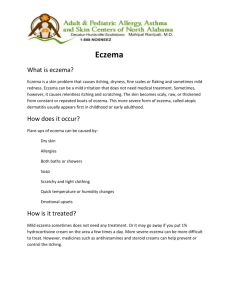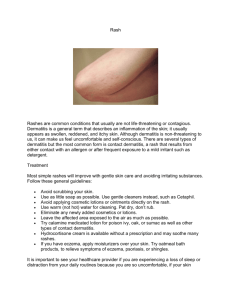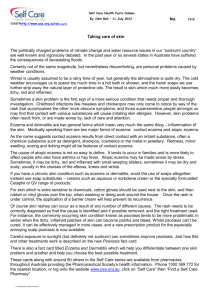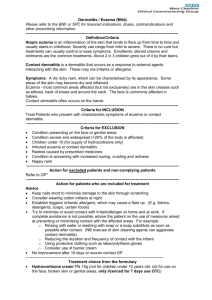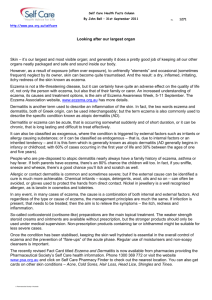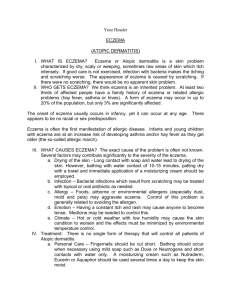Dr. Helen Hu` TCM Newsletter January, 2010 Helen Hu , Medical
advertisement
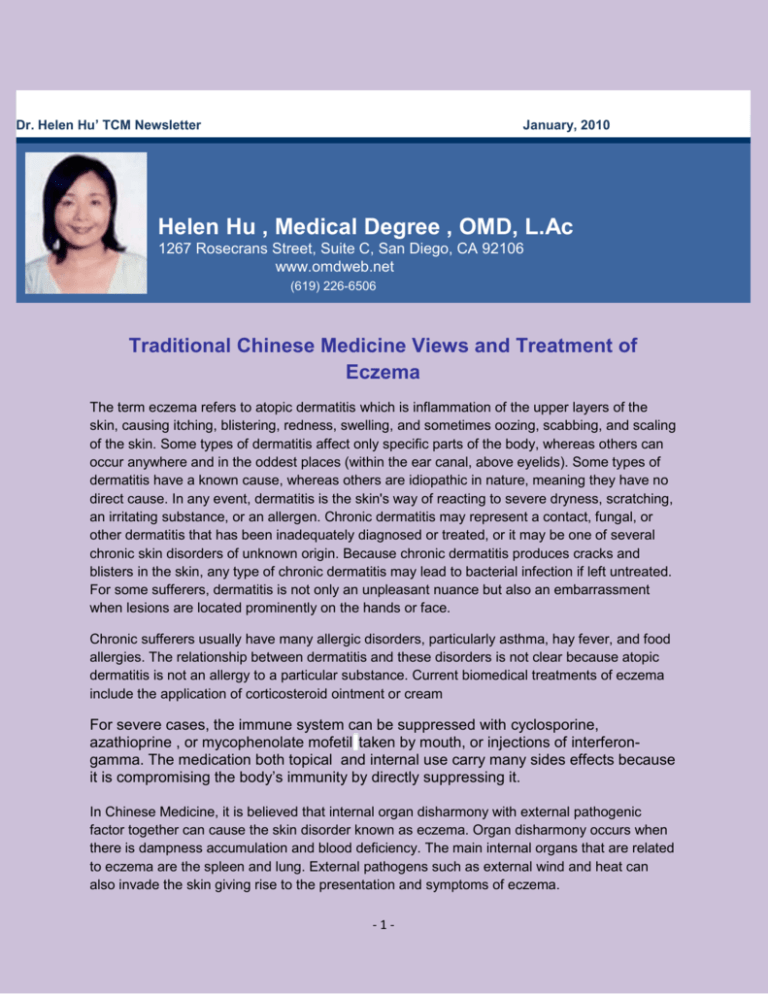
Dr. Helen Hu’ TCM Newsletter January, 2010 Helen Hu , Medical Degree , OMD, L.Ac 1267 Rosecrans Street, Suite C, San Diego, CA 92106 www.omdweb.net (619) 226-6506 Traditional Chinese Medicine Views and Treatment of Eczema The term eczema refers to atopic dermatitis which is inflammation of the upper layers of the skin, causing itching, blistering, redness, swelling, and sometimes oozing, scabbing, and scaling of the skin. Some types of dermatitis affect only specific parts of the body, whereas others can occur anywhere and in the oddest places (within the ear canal, above eyelids). Some types of dermatitis have a known cause, whereas others are idiopathic in nature, meaning they have no direct cause. In any event, dermatitis is the skin's way of reacting to severe dryness, scratching, an irritating substance, or an allergen. Chronic dermatitis may represent a contact, fungal, or other dermatitis that has been inadequately diagnosed or treated, or it may be one of several chronic skin disorders of unknown origin. Because chronic dermatitis produces cracks and blisters in the skin, any type of chronic dermatitis may lead to bacterial infection if left untreated. For some sufferers, dermatitis is not only an unpleasant nuance but also an embarrassment when lesions are located prominently on the hands or face. Chronic sufferers usually have many allergic disorders, particularly asthma, hay fever, and food allergies. The relationship between dermatitis and these disorders is not clear because atopic dermatitis is not an allergy to a particular substance. Current biomedical treatments of eczema include the application of corticosteroid ointment or cream For severe cases, the immune system can be suppressed with cyclosporine, azathioprine , or mycophenolate mofetil taken by mouth, or injections of interferongamma. The medication both topical and internal use carry many sides effects because it is compromising the body’s immunity by directly suppressing it. In Chinese Medicine, it is believed that internal organ disharmony with external pathogenic factor together can cause the skin disorder known as eczema. Organ disharmony occurs when there is dampness accumulation and blood deficiency. The main internal organs that are related to eczema are the spleen and lung. External pathogens such as external wind and heat can also invade the skin giving rise to the presentation and symptoms of eczema. -1- The concept of pathogenic “Wind” in Chinese Medicine means seasonal and climatic changes that can impact the body. Spring time is characterized by more wind and thus chronic eczema patients tend to have recurrent episodes during spring time due to the prevalence of “allergens” being swept up in the air. The concept of “heat” indicate that the “pathogen” can cause skin redness, without blister which can occur from infection, and/or reaction to plants, minerals and chemical substances Certain food can provoke this skin disorder such as: 1. Shell fish: Chinese medicine believe that shell fish and shrimps classified as yang food that easily produce wind, if the body already has certain deficiency, this can lead to itchiness of the skin. 2. Hot spicy food: Spicy foods can cause more dryness due to its nature and ability to consume fluids, which is the body’s source of yin energy that nourish and moisten the skin. 3. Too much sugar, starch products: All those refined carbohydrate food are classified as dampness generating food in the body, which may present as oozing or blistering skin. There are acute and chronic stages of eczema which can be classified by its appearance. Acute eczema presents in the clinic with itching, redness and small blister with yellow exudates. Chronic eczema can be recurrent at the same place, skin become thicken, gray color with severe itching , especially itching at night time with redness scratching marks and scaling. Traditional Chinese Medicine treats Eczema by acupuncture and herbal medicine according to its pattern diagnosis and which organ involved in each individual. In severe case, external herbal formula can be applied locally with much success. Chinese food therapy is one of important preventative measures and part of treatment during its recurrent stages. In cases of acute stage of eczema: Most use herbal formula internally and external to expel external pathogen invasion, such as heat and dampness, at the same time, try to avoid sea food and hot spicy food. In cases of chronic condition eczema: There are both organ deficiency and /or blood deficiency that are involved in chronic cases of eczema. One has to be evaluated by a TCM doctor in order to make pattern diagnosis, then treatment by acupuncture, herbology and diet therapy to address underline organ disharmony and the skin condition. Chinese Food Therapy for Eczema: I. Acute stage: 1. mung bean and hawthorn soup Mung bean: 25g Yi Yi Ren (Coix Seed): 25 g -2- Shan Zha (Hawthorn) 10g Wash it in 500ml water to soak for a hour , the bring it to boiling for 5-10 min. Then cover the lid set for 15 min. Drink it as tea, once a day 2. Celery salad Put fresh celery 250g in boiling water for one min. then take out soaking cold water. Cut it in small pieces adding sot and sesame seed oil. Serve. 1-2 time a day for 7 days. 3. Ku shen egg One egg, ku shen 30g, white sugar 10g Pre soaking Ku shen for 30 min , then bring to boiling for 20 min, then filter out herbs. Add 10 g sugar and the pre- beat egg slowly in the boiling herbal juice. Then serve once a day for 6 day as a course of treatment 4. Kelp with mung bean soup Kelp 15 g ( soak till soft, cut into small pieces) Mung beans 15 g Tea Rose: 6 g ( put into guz bag) Sweet apricot kernel: 9 g Put all above ingredient in pot with water to boil for 30-40 mines. Then take out tea rose bag. Add little dark brown sugar in. drink as tea. One dose a day, 10 days as a course of treatment. II.. Chronic Eczema : Less exudate, but itching is more prevalent most notably at night, there may be scratch marks, with dry skin, some with thickening of the skin, dry month and indigestion. 1. Apple and mung bean juice Mung bean: 30 g. Boiling in water for 30-45 min Juicing of: bay Choy, celery, bitter melon, green apple together. Then mix mung bean juice with all veggie juice, add honey, and half lemon juice. Drink once dose a day. 7 days as a course of treatment. 2. Pear and celery juice Celery: 100g Tomato: one -3- Asian pear 150 g Lemon: half Juicing all above ingredients. The add honey. Drink one dose a day. 7 days as a course of treatment. 3. Walnut Hawthorn Congee: Hawthorn: 9 g Walnuts: 9 g Lotus leaf: half Sweat rice: 60 g Cooking instruction: boiling the hawthorn, walnuts and lotus leaf for 30 minus. Then use the herbal juice only to cook sweat rice to make congee. 4. Mushroom Pork Rice. Shitake mushroom: 100g ( soak 1 hour till soft , then cut into small thin piece) Lean pork: 100g (grounded, or cut into small pieces) Spring rice: 100 g Add all ingredients together in rice cooker with propitiate amount of water. Twice a day as regular meal. Dr. Helen Hu at Traditional Chinese Medical Clinic provide nutritional consultation of Chinese food therapy and tea therapy for each individual condition and promoting prevention and well being. For a consultation, please contact Dr.Hu at (619) 226-6506 -4-

